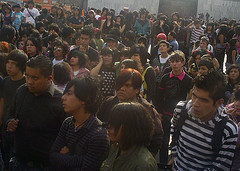I recently discovered a series on Chicago Public Radio which features reports from Greg Scott, a sociology professor and documentary filmmaker.
The most recent installment explores the daily lives of women working as prostitutes on Cicero Avenue in Chicago’s West Side. Scott’s story paints a vivid picture of the complex relationship between sex and pride for these women…
Listen to ‘Women of the Brickyard’ here.
For more of Scott’s stories, look here.



 The Houston Chronicle
The Houston Chronicle The
The